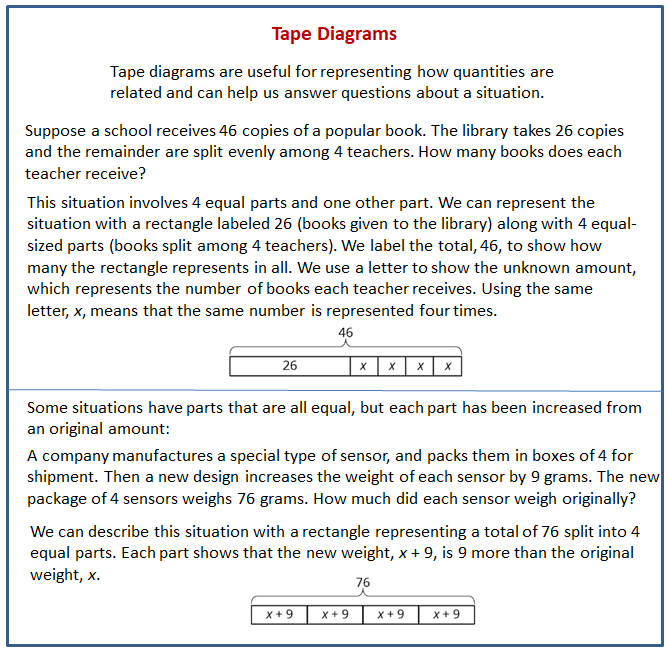Illustrative Mathematics Grade 7, Unit 6, Lesson 2: Reasoning about Contexts with Tape Diagrams (Part 1)
Learning Targets:
- I can explain how a tape diagram represents parts of a situation and relationships between them.
- I can use a tape diagram to find an unknown amount in a situation.
Related Pages
Illustrative Math
Grade 7
Lesson 2: Reasoning about Contexts with Tape Diagrams (Part 1)
Let’s use tape diagrams to make sense of different kinds of stories.
Illustrative Math Unit 7.6, Lesson 2 (printable worksheets)
Lesson 2 Summary
The following diagram shows how a tape diagram represents parts of a situation and relationships between them.

Lesson 2.1 Remembering Tape Diagrams
- What do you notice? What do you wonder?
- What are some possible values for a, b, and c in the first diagram? For x, y, and z in the second diagram? How did you decide on those values?
Lesson 2.2 Every Picture Tells a Story
Here are three stories with a diagram that represents it. With your group, decide who will go first. That person explains why the diagram represents the story. Work together to find any unknown amounts in the story. Then, switch roles for the second diagram and switch again for the third.
- Mai made 50 flyers for five volunteers in her club to hang up around school. She gave 5 flyers to the first volunteer, 18 flyers to the second volunteer, and divided the remaining flyers equally among the three remaining volunteers.
- To thank her five volunteers, Mai gave each of them the same number of stickers. Then she gave them each two more stickers. Altogether, she gave them a total of 30 stickers.
- Mai distributed another group of flyers equally among the five volunteers. Then she remembered that she needed some flyers to give to teachers, so she took 2 flyers from each volunteer. Then, the volunteers had a total of 40 flyers to hang up.
Lesson 2.3 Every Story Needs a Picture
Here are three more stories. Draw a tape diagram to represent each story. Then describe how you would find any unknown amounts in the stories.
- Noah and his sister are making gift bags for a birthday party. Noah puts 3 pencil erasers in each bag. His sister puts stickers in each bag. After filling 4 bags, they have used a total of 44 items.
Open Applet - Noah’s family also wants to blow up a total of 60 balloons for the party. Yesterday they blew up 24 balloons. Today they want to split the remaining balloons equally between four family members.
Open Applet - Noah’s family bought some fruit bars to put in the gift bags. They bought one box each of four flavors: apple, strawberry, blueberry, and peach. The boxes all had the same number of bars. Noah wanted to taste the flavors and ate one bar from each box. There were 28 bars left for the gift bags.
Open Applet
Are you ready for more?
Design a tiling that uses a repeating pattern consisting of 2 kinds of shapes (e.g., 1 hexagon with 3 triangles forming a triangle). How many times did you repeat the pattern in your picture? How many individual shapes did you use?
Lesson 2 Practice Problems
- The table shows the number of apples and the total weight of the apples.
Estimate the weight of 6 apples. - Select all stories that the tape diagram can represent.
A. There are 87 children and 39 adults at a show. The seating in the theater is split into 4 equal sections.
B. There are 87 first graders in after-care. After 39 students are picked up, the teacher put the remaining students into 4 groups for an activity.
C. Lin buys a pack of 87 pencils. She gives 39 to her teacher and shared the remaining pencils between herself and 3 friends.
D. Andre buys 4 packs of paper clips with 39 paper clips in each. Then he gives 87 paper clips to his teacher.
E. Diego’s family spends $87 on 4 tickets to the fair and a $39 dinner. - Andre wants to save $40 to buy a gift for his dad. Andre’s neighbor will pay him weekly to mow the lawn, but Andre always gives a $2 donation to the food bank in weeks when he earns money.
Andre calculates that it will take him 5 weeks to earn the money for his dad’s gift. He draws a tape diagram to represent the situation.
a. Explain how the parts of the tape diagram represent the story.
b. How much does Andre’s neighbor pay him each week to mow the lawn? - Without evaluating each expression, determine which value is the greatest. Explain how you know.
- Solve each equation.
The Open Up Resources math curriculum is free to download from the Open Up Resources website and is also available from Illustrative Mathematics.
Try out our new and fun Fraction Concoction Game.
Add and subtract fractions to make exciting fraction concoctions following a recipe. There are four levels of difficulty: Easy, medium, hard and insane. Practice the basics of fraction addition and subtraction or challenge yourself with the insane level.

We welcome your feedback, comments and questions about this site or page. Please submit your feedback or enquiries via our Feedback page.